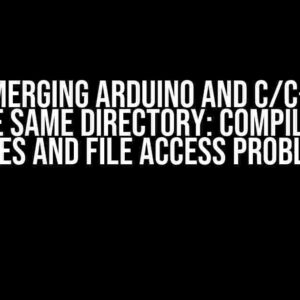Are you stuck in a loop (pun intended)? If you’re wondering why your independent loops in LabView within case structures aren’t running simultaneously, you’re in the right place! In this article, we’ll dive into the reasons behind this phenomenon and provide you with the solutions to get your loops running in harmony.
The Mysterious Case of Non-Simultaneous Loops
Before we dive into the solutions, let’s first understand what’s going on behind the scenes. In LabView, when you have two independent loops within case structures, you’d expect them to run simultaneously, right? After all, they’re independent, and you’ve got the processing power to spare. However, that’s not always the case.
The culprit behind this behavior is LabView’s execution model. By design, LabView executes code sequentially, following the data flow principle. This means that each node (including loops) is executed one after the other, based on data availability. Even if you have multiple cores or processors, LabView will still execute the code sequentially.
Why Not Simultaneous Execution?
But why can’t LabView execute your independent loops simultaneously? There are several reasons for this:
- Data Dependencies**: Even if your loops are independent, they might still have data dependencies that prevent them from running simultaneously. If one loop relies on data produced by the other, LabView will execute them sequentially to ensure data integrity.
- Resource Constraints**: LabView needs to allocate resources (such as memory and CPU time) for each loop. If the system is resource-constrained, LabView might prioritize one loop over the other, leading to sequential execution.
- Synchronization**: To maintain data consistency and prevent race conditions, LabView might need to synchronize access to shared resources, leading to sequential execution.
Solutions to the Non-Simultaneous Loop Conundrum
Don’t worry; there are ways to get your loops running simultaneously in LabView! Here are some solutions to overcome the limitations:
1. Use SubVIs
One approach is to create SubVIs for each loop and execute them as separate threads using LabView’s Invoke Node. This allows LabView to execute the SubVIs concurrently, utilizing multiple cores or processors.
// Create a SubVI for each loop
SubVI 1: Loop 1
SubVI 2: Loop 2
// Use the Invoke Node to execute the SubVIs
Invoke Node (VI Server)
|____________|
| SubVI 1 |
|____________|
| SubVI 2 |
|____________|
2. Utilize Timed Loops
Another approach is to use timed loops, which allow you to set a specific execution time for each loop. By staggering the start times, you can achieve pseudo-simultaneous execution.
// Loop 1
Timed Loop (Start Time: 0ms, Period: 10ms)
|____________|
| Loop 1 Code |
|____________|
// Loop 2
Timed Loop (Start Time: 5ms, Period: 10ms)
|____________|
| Loop 2 Code |
|____________|
3. Leverage LabView’s Multithreading Capabilities
LabView provides built-in support for multithreading through the OpenG library. You can create threads for each loop and execute them simultaneously using the Thread function.
// Create a thread for each loop
Thread 1 = Thread(Loop 1 Code)
Thread 2 = Thread(Loop 2 Code)
// Start the threads
Start Thread(Thread 1)
Start Thread(Thread 2)
4. Use a State Machine
A state machine can be used to control the execution of your loops. By implementing a finite state machine, you can orchestrate the loops to run simultaneously while ensuring data consistency and resource allocation.
// State Machine
Enum: Loop States
Idle
Loop 1 Running
Loop 2 Running
Both Loops Running
Case Structure (Current State)
Idle:
// Initialize loops and set state to Both Loops Running
Loop 1 Running:
// Execute Loop 1
Loop 2 Running:
// Execute Loop 2
Both Loops Running:
// Execute both loops simultaneously using SubVIs or timed loops
Best Practices for Simultaneous Loop Execution
When implementing simultaneous loop execution, keep the following best practices in mind:
- Use Synchronization Mechanisms**: Ensure data consistency by using synchronization mechanisms like semaphores, mutexes, or rendezvous nodes to coordinate access to shared resources.
- Optimize Resource Allocation**: Optimize resource allocation by using LabView’s built-in resource management features, such as resource constraints and priority scheduling.
- Profile and Optimize**: Profile your code to identify performance bottlenecks and optimize accordingly. This might involve refactoring code, using more efficient algorithms, or leveraging LabView’s parallel processing capabilities.
- Test and Validate**: Thoroughly test and validate your code to ensure it behaves as expected, especially when executing loops simultaneously.
Conclusion
In conclusion, LabView’s execution model can sometimes lead to non-simultaneous execution of independent loops within case structures. However, by understanding the underlying reasons and applying the solutions outlined in this article, you can overcome these limitations and achieve simultaneous loop execution. Remember to follow best practices to ensure data consistency, optimize resource allocation, and profile your code for optimal performance.
| Summary of Solutions |
|---|
| 1. Use SubVIs and Invoke Node |
| 2. Utilize Timed Loops |
| 3. Leverage LabView’s Multithreading Capabilities |
| 4. Use a State Machine |
By applying these solutions and best practices, you’ll be well on your way to creating efficient, parallelized code in LabView. Happy coding!
Frequently Asked Question
Get the scoop on why those independent loops in LabView within case structures aren’t running simultaneously like you expected – we’ve got the answers!
Why don’t independent loops within case structures run simultaneously in LabView?
This is because LabView executes code sequentially, following the data flow model. Even if you have independent loops within case structures, LabView will still execute them one at a time, following the sequence of the code. It’s like a production line – each task must be completed before moving on to the next one!
But I thought LabView was supposed to be parallelizable?
You’re right! LabView can be parallelizable, but not in this case. The issue here is that the loops are within a case structure, which is a sequential construct. To achieve parallelism, you’d need to use parallelizable elements like parallel loops, Timed Loops, or even separate VIs running in parallel. It’s like having multiple production lines working simultaneously – but you need the right machinery for it!
What’s the deal with data flow programming in LabView?
Data flow programming is LabView’s programming paradigm, where the flow of data determines the execution of code. This means that LabView will execute code only when there’s data available at the input, and it will stop when there’s no more data. It’s like a water flow – the code is executed as the data flows through it, and it stops when the water runs dry!
Can I use parallel loops or Timed Loops to get around this limitation?
You’re on the right track! Yes, you can use parallel loops or Timed Loops to achieve parallelism in LabView. These constructs are designed to execute tasks simultaneously, allowing you to take advantage of multi-core processors. Just be aware that you’ll need to properly synchronize data exchange between loops to avoid data corruption. It’s like coordinating multiple teams working together – you need to get the communication right!
What’s the best way to troubleshoot issues with parallel code in LabView?
When troubleshooting parallel code, it’s essential to use the right tools. LabView provides features like the Execution Trace, the Debugging Tools, and the Performance Monitor to help you identify bottlenecks and synchronization issues. It’s like having a team of detectives helping you crack the code – you just need to know where to look!



